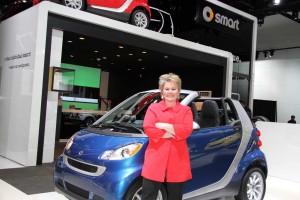
With the brand's sales off another 60%, last year, Smart USA boss Jill Lajdziak can only hope and wait for the distributor's planned 4-seat model.
It was the hit of 2008, its U.S. launch inadvertently timed to take advantage of the record run-up in fuel prices. But since then, things haven’t gone nearly so well for the little Smart USA brand, which reported a nearly 60% drop in sales, last year alone, even as most makers reported double-digit gains.
In a bid to stave off disaster, the U.S. distributor, which is operated by Detroit entrepreneur Roger Penske, plans to introduce an all-new model later this year that will be built for it by Nissan, rather than Daimler, the German parent of the Smart brand.
Might even more products be added to the U.S. line-up that aren’t available to Smart buyers in other parts of the world? That’s not out of the question, according to various company officials who are betting that Smart can rebound from its disastrous tumble.
“We’ve got a business to run,” and that means that Smart USA may have to make some critical moves that aren’t necessarily what the folks at Daimler AG headquarters, in Stuttgart would like,” acknowledges Jill Lajdziak, the U.S. distributor’s boss.
The former head of General Motors’ now-abandoned Saturn brand, Lajdziak is quick to stress that the goal is still to work together. “We have to find the balance between how we feel we need to expand the portfolio and what Daimler feels it needs.”
But the two companies clearly won’t always be in sync – as Smart USA will demonstrate with the launch, later this year, of a four-door minicar developed for it by Nissan — and built on one of the Japanese maker’s U.S. assembly lines. The move is ironic because Daimler is working with Nissan’s French alliance partner, Renault, on a number of products – as well as powertrains and other components – for both Smart and the upscale Mercedes-Benz brand.
But the projects pairing Renault directly with Daimler won’t be out until 2014. Smart USA simply couldn’t wait that long.
In 2008, with fuel prices soaring, the brand’s little fortwo two-seater seemed perfectly suited to the apparently new realities of $4 a gallon gas. But when prices began to fall, so did Smart sales, from a peak of about 25,000 in 2008 to just 14,595 the following year. In 2010, the numbers were off another 59.4%, to a meager 5,927 for the entire year – an unsustainable number.
Smart “absolutely” has to get the bigger car from Renault out in market as soon as possible, conceded Lajdziak, along with the low-volume battery car based on the maker’s fortwo model.
As for the gas-powered version, she insists “we’re not going to walk away from it,” though it’s clear the U.S. market has. Precisely why is debatable. Certainly, one fuel prices started tumbling U.S. consumers started switching back to the type of vehicles they would prefer. But the fortwo has continued to lose momentum even while other small cars – such as Ford’s new Fiesta subcompact – are gaining ground.
Blame a woefully inadequate transmission and mileage that can only be described as mediocre, suggest the automotive reviewers, who have largely turned thumbs down on the 4-2.
Nonetheless, Lajdziak is upbeat about the future, insisting the brand has not been permanently tarnished. Quite the opposite. “People like what the brand stands for,” she says, sitting at the Smart booth at the Detroit Auto Show.
Whether she’s right will become apparent in less than a year when the Smart brand gets just a wee bit bigger.
